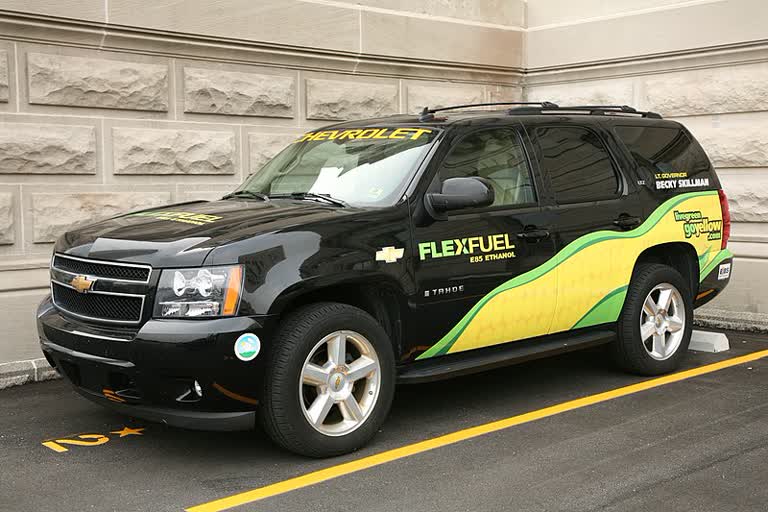New Delhi: Union Road Transport and Highways Minister Nitin Gadkari has recently announced that the government is likely to issue an order at the earliest asking automobile makers in the country to mandatorily produce Flex Fuel Vehicles (FFVs) to help vehicle users in saving costs and also farmers in generating more income. The minister’s statement, which comes in the backdrop of the recent decision of the Centre to advance the target of 20 per cent ethanol blended petrol by five years to 2025, has triggered a debate on the efficacy of FFVs in India.
Against this backdrop, ETV Bharat has reviewed the ‘Road Map For Ethanol Blending in India 2020-25’, a report released by the NITI Aayog this month discussing the feasibility of FFVs in the country. Here are the details.
What are Flex Fuel Vehicles (FFVs)?
Essentially, the concept of FFV has been proposed in view of the rising ethanol percent in petrol. According to the NITI Aayog report, FFVs have compatible engines to run on more than 84 per cent ethanol blended petrol. In fact, these vehicles are a logical extension of the Ethanol Blended Petrol (EBP) programme launched by the Union Ministry of Petroleum and Natural Gas in January 2003. The programme makes it mandatory on the part of oil marketing companies like Indian Oil, HPCL, BPCL, etc to sell ethanol blended petrol.
Last year, the Centre had set a target of reaching 10 per cent ethanol blending in petrol by 2022 and 20 per cent mixing by 2030. However, the target was revised recently by five years to 2025. At present, about 8.5 per cent ethanol is mixed with petrol as against 1-1.5 per cent in 2014.
What are the advantages of ethanol blended fuels and FFVs?
According to the government, usage of ethanol blended fuel will benefit consumers, farmers and the Indian economy as a whole. “Alternative fuel ethanol is Rs 60-62 per litre while petrol costs more than Rs 100 per litre in many parts of the country, so by using ethanol, Indians will save Rs 30-35 per litre,” Nitin Gadkari said last week. The minister further observed that since India has surplus produce of corn, sugar and wheat, the mandatory blending of ethanol programme will help farmers in realising higher incomes.
He also emphasised the fact that excess supply of foodgrains has been creating problems since we don’t have enough infrastructure to store the excess supplies. "Our minimum support prices (MSP) of crops is higher than international prices and domestic market prices, so the government has taken the decision that you can make ethanol by using foodgrains and sugarcane juice," he added. For the overall Indian economy, higher usage of ethanol as an automobile fuel will help save import costs as the country meets more than 80 per cent of its crude oil requirements through imports.
What are the disadvantages/challenges of using FFVs?
According to the NITI Aayog, customer acceptance will be a major challenge since the cost of ownership and running cost are going to be very high compared with 100 per cent petrol vehicles. “It should be noted the flex fuel vehicles themselves could be more expensive than regular vehicles due to the upgradation of materials, engine parts and fuel system. Further, running cost (due to lower fuel efficiency) will be higher by more than 30 per cent when run with 100 per cent ethanol (E100),” said the NITI Aayog report.
Experts further point out that Flex Fuel Engines cost more as ethanol has very different chemical properties than petrol. “Ethanol has very low (40 per cent) Calorific value as compared to Gasoline, very High Latent heat of vaporization causing cooling of charge/combustion etc. Ethanol also acts as a solvent and could wipe out the protective oil film inside the engine thereby could cause wear and tear… engines very specific to run in Flex fuel environment lead to increase in cost of the engine,” observed the report.
According to the Society of Indian Automobile Manufacturers (SIAM), the cost of FFVs (four-wheelers) would be higher in the range of Rs 17,000 to Rs 25,000. The two-wheeled flex fuel vehicles would be costlier in the range of Rs 5,000 to Rs 12,000 compared to normal petrol vehicles.
What is the way forward?
In view of higher costs incurred by customers, the report suggested that India should switch to 100 per cent ethanol only after the careful assessment of the pan-India roll out of the 20 per cent ethanol blended petrol programme. “Investing in development of such vehicles (FFVs) is not viable if the fuel is not available across the country. Hence, SIAM recommends not to pursue E100 implementation / flex fuel approach till the E20 fuel availability and usage is established pan India basis and clear visibility of higher blends is foreseen,” concluded the report.
